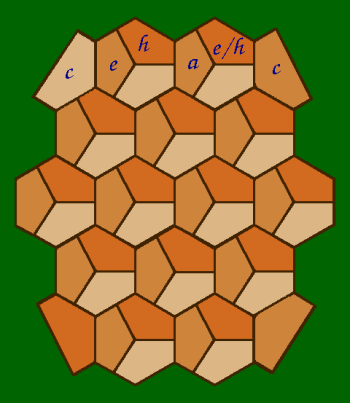Penturanga
This is my pentagonal-cell entry for the 45 or 46 cell 2007 design
competition.  It takes the pieces from Chaturanga and adapts their movement to a board with pentagonal cells.
WINNER 45-46 Square Contest
JJ, editor, CV********************
Setup
| The board is constructed from 46
convex pentagons. There are two players, each player having 14 pieces consisting of: The board and initial placement of the pieces are shown by the image on the right. |
 |
Pieces
|
The Adviser or Counsellor may move a single step to any one of the 6 adjacent cells. This is the same as the King's normal move, but untrammelled by the need to avoid being attacked. In the image on the right these 6 adjacent cells are indicated by grey dots. |
 |
The Elephant leaps over an adjacent cell to
land on a cell whose colour matches that of the cell from which the
piece is moving.
In the image on the right the six possible destination cells are shown with a grey dot. Since the move involves a leap the Elephant cannot be blocked by a piece occupying an adjacent cell. Â |
 |
The Horse or Knight leaps over an adjacent cell
to land on a cell whose colour differs from that of the starting cell.
In the image on the right the six possible destination cells are shown with a grey dot. Since the move involves a leap the Horse cannot be blocked by a piece occupying an adjacent cell. Â Â |
 |
The Chariot or Rook moves outwards from its starting
cell in a series of steps that cycle through the colours.Â
Thus, after the initial step, each subsequent step must continue away from the starting cell to a cell whose colour differs both from that of the current cell and from that of the cell just vacated. In the image on the right the reachable cells are indicated by grey dots. The Chariot may not leap over other pieces. Â |
 |
The Pawn moves a single step, 1 cell directly
forward.
When moving directly forward the Pawn may not capture and may not leap over other pieces. In the image on the right these moves are shown by grey dots. Pawns capture by moving forward and to the side. When moving forward and to the side Pawns must make a capture These capture-moves are shown by red dots. There is no initial double-move and thus no En-Passant capture. |
 |
| Promotion Pawns may promote when they reach one of the 6
far most cells.
Promotion is to the piece that originally occupied the cell reached or, in the case of horses, occupied the cell directly in front of that reached. Promotion is only possible if a piece of the required type has been captured and not been returned to the board. For the Gold player the image on the right shows the possible promotions:
|
 |
The King may move a single step to an adjacent
cell provided that cell is not being attacked.
In the right-hand image the 6 possible steps are shown by grey dots. Additionally, once during the game, the King may make a Horse's leap. To make the leap, the King must not be in check and the destination cell must be free from attack. This leap is illustrated by the red dots. |
 |
Rules
There are two players, shown here as Gold and Red.
A player wins by
checkmating the enemy King.
A player loses if they stalemate their opponent.
Turns, consisting
of moving a single friendly piece, alternate
between the players with Gold going first.
The movement of each type of piece is summarized above.
 This 'user submitted' page is a collaboration between the posting user and the Chess Variant Pages. Registered contributors to the Chess Variant Pages have the ability to post their own works, subject to review and editing by the Chess Variant Pages Editorial Staff.
This 'user submitted' page is a collaboration between the posting user and the Chess Variant Pages. Registered contributors to the Chess Variant Pages have the ability to post their own works, subject to review and editing by the Chess Variant Pages Editorial Staff.
By Graeme C Neatham.
Web page created: 2007-11-26. Web page last updated: 2007-11-26
